Tags
Chopta Valley, Gangtok, Gurudongmar Lake, Indian Army, Kanchenjunga, Kangchenjunga, Lachen, Lachung, North East India, North Sikkim, Sikkim, Tibet
Hi, A warm welcome to my blog 🙂
I hope you all have enjoyed my previous post in this travel series:
My Adventures in Darjeeling, Sikkim & Kalimpong – Part 4 of 7
And now, here’s the continuing story… Happy reading 🙂
Friday, 19 September 2014
I wake up in the middle of the night. It’s 3:30 AM. I drift back to sleep. Some time later, I’m awake again. It’s 5:30 AM. I loll in bed for a few minutes till realization hits me. Damn, I missed the sunrise! I quickly rush out of bed and run towards the window. Today, the snow peaks are clearly visible! A nearby building obstructs my full view but I can see the snow-covered mountain range quite clearly. In fact much more better than last morning. Is it really the Kanchenjunga range? Was yesterday’s snowy peak really Kanchenjunga? Are my eyes playing tricks on me? Instead of taking photographs, I focus all my attention on the beautiful mountains in the distance. And then, the air is filled with the sound of Akon’s “Beautiful” What??? Someone is playing English songs at 6:00 AM??? I’m absolutely delighted by the song! You’re so beautiful, so damn beautiful… Ooh, such a beautiful day! I have fully recovered from last night’s sickness so I’m most definitely going to North Sikkim today. The weather is bright and sunny. Yesterday at about 4:45 AM, I heard sounds coming from downstairs like somebody moving furniture. Most probably, the cleaning staff doing their job. Even now, I can hear somebody downstairs. The people here seem to wake up early. From the window, I can see the womenfolk in nearby houses going about their morning tasks. I dial up room service for a jar of warm drinking water and it’s delivered within a short while.
The snow-covered peaks have disappeared behind the clouds but the rocky peaks ahead of them are still visible. “Is that the Kanchenjunga range?” I ask the room attendant. “No, Kanchenjunga cannot be seen from here. You’ll be able to see it from the stadium, down the road.” I tell him about the snow peak that I have seen from the travel agency. He’s clueless. So, like the guys at the agency, he hasn’t seen it too! “It snows in December-January,” he goes on. Hmmm…
At 7:30 AM, I have a light breakfast of toast and butter and another jar of warm water. By 9:30 AM, I’m ready to check out from the hotel. The youngster from the travel agency is waiting downstairs. My hired vehicle is at the taxi stand and to reach there we need to take a taxi. Okay, as long as you’re paying for it! I mean he should have told the taxi driver to come to the hotel instead!
At the taxi stand, the Tata Sumo vehicle is waiting. At the taxi stand, the Tata Sumo vehicle is waiting. Tobgay, the young driver doesn’t speak English. But he speaks Hindi so it’s fine. By the time we start off the journey, it’s 10:00 AM. Like an excited kid, I feel like shouting “Yay, I’m off to North Sikkim!” Having seen plenty of amazing photographs of North Sikkim, I’m eager to breathe the cleanest of clean air of this most beautiful, breathtaking and pristine part of Sikkim with rough terrain.
North Sikkim is a land of high passes, glaciers and remote snowbound terrain. Both Lachen and Lachung are well-known for their picture postcard beauty, rich alpine flora and scenic splendour. The peak seasons are March-May and October-January. In the flowering season of March, the Yumthang “Valley of Flowers” near Lachung becomes a hotspot for tourists. In winter, the entire region is covered with snow and all its lakes get frozen. It’s an amazing sight but winters are very harsh in this high-altitude region. I have chosen to visit when the weather is less cold and there are fewer tourists. When Tobgay asks for my itinerary, I’m ready. One night in Lachen and two nights in Lachung. He says that Lachen would be very cold since it is at a higher altitude than Lachung. I had read on online travel forums that Lachen being smaller than Lachung, its hotels aren’t equipped with room heaters. In Lachung, there are just two or three hotels with room heaters and one of them is Hotel Fortuna Lachung. So staying in Lachen for two nights and one night in Lachung would be a good idea only in the warm months from March to May. A homestay accommodation would be a wonderful way to connect with the locals and experience their cuisine. Tobgay tells me there are homestays at both places. As private taxi driver, he makes trips to North Sikkim in all seasons. And his village is somewhere on the way. I proceed to tell him about the sunrise over snow-capped mountains from my room window and the snow peak that I have seen from the travel agency yesterday. I ask him if it could be the Kanchenjunga. Now go on, tell me that it can’t be Kanchenjunga! But no, instead he replies, “It must be Kanchenjunga.” WHAT??? He says that on a clear day Kanchenjunga is visible even from my hotel road and best viewed from the football stadium down the road. Ohhh…
I’m keen on trying the local drinks of this region, especially Chang, the locally brewed millet beer. This popular drink is served in a bamboo vessel called “Tongba” which looks like a wooden barrel with a small bamboo pipe poked into it. Hot water is poured into the barrel containing fermented millet and kept for a few minutes before sipping the drink through the bamboo pipe. Once the beer runs out, hot water is again poured into the barrel 10-15 minutes before having it. The process is repeated till the millets lose their potency. An ideal drink for people who have very little to do on a high altitude mountain settlement. It keeps them warm. Local healers prescribe it to the sick and women who have just given birth.
Chang can be a bit strong. Whatever, no harm in trying some. Not wanting to run into any more health problems that might hinder my visit to the high-altitude Gurudongmar Lake, I decide to try Chang after returning from the lake, maybe somewhere in Lachung. Due to my cough problem, I haven’t even tried the popular beer of Sikkim called Hit. A local favourite, it’s manufactured by breweries owned by Bollywood star Danny Denzongpa, who is from Sikkim. Sikkim has its own local distilleries that manufacture and sell liquor. And yet, its many alcohol brands are unheard of in the rest of the country.
Due to landslides on the road to North Sikkim via the 18th century Phodong Monastery, we have to take an alternate route which is a bit longer. So I’m unable to visit the sacred spot of Kabi Longstok, some 17 km from Gangtok on the North Sikkim road, where the pact of blood brotherhood was sworn between the Lepchas and the Bhutias in the 15th century. Nine stones were erected facing the Kanchenjunga to witness the treaty of brotherhood between the Lepchas and the Bhutias. The spot where the ceremony took place is marked by a memorial stone pillar amidst the cover of dense forest.
The music playing in the vehicle is a mix of Sikkimese pop and Hindi film songs. Tobgay says that other than a few World Cup football songs, there are no English songs in the playlist. That’s okay. The Sikkimese songs sound good and the old, melodious Hindi film songs go well with the beautiful landscape.
I stop to take in this lovely view of the Teesta River, the lifeline of Sikkim.
The Teesta River remains a constant companion throughout the road journey from Gangtok to Siliguri. It originates from the Pahunri (Teesta Kangse) glacier in the north and is fed by waters from the mountains including Lachen and Lachung rivers, as it flows down south through the Himalayan gorges. On the way, it’s joined by Rangpo and Rangit rivers before entering West Bengal at Sevoke, 22 kms from Siliguri. The turbulent waters of both Teesta and Rangit are very popular with rafting aficionados. In fact, river rafting is a common sport practised in the raging waters of Teesta.
Around 12:00 PM, we reach Mangan, the district headquarters of North Sikkim. This small town, 65 km away from Gangtok, is a transit point to other destinations in this region. While Tobgay goes for lunch at a nearby place, I shop for bananas and mineral water bottles. Mineral water bottles are banned in Lachen so it would be better to stock a few. A short while later, Tobgay returns. I ask him what he had for lunch and he says, chicken momos. I’m currently keeping off non-vegetarian food. But at the word “momos”, my eyes perk up and my mouth starts watering. It’s a pity that I can’t eat anything till I reach Lachen. I’m so tempted to go to the restaurant for vegetable momos but the thought of throwing up on the way makes me change my mind.
Leaving Mangan behind, we continue our journey through the high mountains. Like in West Sikkim and the road to Nathula, here too, the road looks mostly good, except for places where there are landslides or where water flows across the road.
Half an hour later, we stop at Singhik View Point, about four kilometres from Mangan. On a clear day, it offers a magnificent view of the Kanchenjunga range and surrounding hills but today, it’s cloudy.
Five minutes later, I stop at the Myang Falls. With a thundering sound, the water hits the rocks, gushing out of culverts under the road before flowing down the valley below. Then I see something else. Stuck between two rocks is a beaded garland from the Vishwakarma immersion ceremony which concluded yesterday morning. Tobgay tells me that devotees look for cleaner waters to immerse Lord Vishwakarma idols. Hmmm, I just hope that the immersed idol was environment-friendly.
Watch my video: Myang Falls
We drive on. Twenty minutes later, we stop at another waterfall…the Naga Falls.
Watch my videos: Naga Falls – 1 Naga Falls – 2
Here again, the water flows under the road bridge into the valley.
It is a beautiful drive and the temperature is cooler. All this while, I have been listening to nice old Hindi songs playing in the vehicle until Shakira’s latest rocking number LaLaLa comes up. “Do you know who the singer is?” I ask Tobgay. “Shakira,” he grins. “Khatarnak nachti hain” (She’s a deadly dancer). Absolutely! The next two songs are of Bryan Adams and they are not football songs. Tobgay doesn’t like his third song “Everything I do” which he probably thinks is a sad song. He plays the next song. Hmmm… The first and also the last music concert that I have attended of any international pop star has been that of Bryan Adams. And that was way back in 1993 when he performed in Mumbai on his first visit to India. Sitting on the shoulders of a tall guy right in front of the stage, I locked eyes with the handsome pop star (my favourite at that time) for almost a minute. And then…I broke off the eye contact to look at his long-haired guitarist! It seems so funny now, after twenty-two years. “Everything I do” was one of his latest popular songs at that time and I loved it then. His husky voice and the beautiful lyrics were perfect for the “Robin hood” movie. I had memorised the entire song at that time and used to sing it. Hmmm, how time flies!
Climbing uphill for about half an hour or so, we reach a check post where my permit is examined. A little later, we are at Chumthang, a small village situated at the confluence of the two rivers, Lachen and Lachung, tributaries of the mighty Teesta River. It’s about 95 kms from Gangtok. I stop for a bird’s-eye view of the ongoing Teesta hydroelectric project.
From Chumthang, the North Sikkim highway bifurcates into two, one heading towards Lachen, about 27 km away and the other towards Lachung, about 20 km away. We head westward towards the higher alpine region of Lachen.
Tobgay points out a mountain ahead with clusters of tall white prayer flags attached to poles. In Buddhist culture, people put up 108 white prayer flags to honour their deceased relatives. Tobgay says he has planted a few of them there along with some cousins on the death of a close relative. Why only 108? Because it’s a sacred number in Buddhism. To please the soul of the deceased, prayer flags are planted at places having a gentle breeze and pure and fresh air. Hence mountains are the first choice. It’s believed that when the prayer flags flutter in the wind, even with the slightest breeze, the prayers and blessings are activated, and are carried through the air in a spiritual vibration across the vicinity. Not only does the flag planter, but everything that’s touched by the wind, and all sentient beings, benefit from the prayers and blessings that are carried by the wind.
We reach a small hill village after Chumthang. This is Tobgay’s village. His sister lives here. He goes to her house, adorned with colourful flowering potted plants, and returns a few minutes later with a large can of diesel to fill the diesel tank. Driving on, the landscape becomes absolutely stunning. Misty mountains hovering around while the Lachung river speeds forcibly through the stone boulders in a crashing roar alongside the road.
Watch my videos : Lachung River – 1 Lachung River – 2
I stop at many places to take photographs but they do no justice to the picturesque scenery. This is one of the most beautiful landscapes I have driven through. I ask Tobgay if the locals catch river fish. He says no, fishing is not allowed in any of the rivers in Sikkim. Oh, really? Maybe he isn’t aware of the trout-fishing camps promoted for adventure tourism in North Sikkim. He tells me that the people of North Sikkim don’t kill animals. They are peace-loving people. Meat and chicken comes from Gangtok. What about the nice-looking healthy goats? They are raised for wool, not meat. He tells me that most hotels in this region serve only vegetarian food.
As we drive through the steep mountainous road nearing Lachen, all my senses are stimulated by the stunning surroundings and cleanest air…
Watch my video: En route to Lachen
I look on wide-eyed as we drive past gigantic mountains, covered in mist. The captivating surroundings leave me spellbound. Sky high mountains and deep valleys are a common sight in the other northeast Indian states too but Sikkim is exceptionally beautiful. And, North Sikkim just defies description! I’m totally smitten by this enchanting land. It feels as though I have set foot in paradise. I have experienced this feeling only once before… in Ladakh. It was the first time I fell in love at first sight with a place! I can only imagine how incredibly beautiful it must be during winter: these sky-hugging mountains covered with thick snow. All this while, I have kept my camera aside to absorb the stunningly beautiful surroundings. We drive in complete silence as the sublime beauty of this awesome place has left me dumbstruck with awe.
Soon, we are in the small village of Lachen. It is 4:00 PM and the weather is bad. Instead of towering snow peaks and lush-green valleys, I see thick fog everywhere! Tobgay gets down to present my permit and register the vehicle entry at the police station. Except for some construction activity at a place, the village looks deserted. Tobgay makes enquiries for accommodation but since it’s off-season, everything is closed. There’s nothing ahead so he reverses the vehicle and drives back to take an uphill road alongside which stands a five-storeyed building, “Hotel View Point”. He tells me that it’s a very good hotel. I step out and face the chilly air, protected by thick clothing, hat and gloves, and a woollen shawl covering my face.
The hotel looks deserted. Climbing up the stairs, I call out to see if anybody is around but nobody answers. Reaching the first floor, I just see locked rooms but no office. Tobgay joins me in searching for the hotel staff. He finds the hotel manager, Bhaichung. The normal room tariff is 3000 rupees including breakfast, lunch and dinner but since it’s off-season the young man agrees to give me a 50% discount. He has kept a room ready for a foreign couple who are due to arrive. It’s a comfortable room and the bathroom, although not to my liking, is okay for a night. Once the accommodation is arranged, Tobgay leaves. I have told him to knock at my door at 4:15 AM the next morning to start for Gurudongmar Lake.
The hotel balcony offers a good view of the small village. But right now, it’s foggy and bone-chilling cold.
Watch my video: View from my Lachen hotel
At an elevation of 8500 feet, about 120 km from Gangtok, Lachen is a remote hamlet of fewer than 200 houses. Being close to the Northern borders of Sikkim and the higher reaches of the Himalayas, it’s the starting point for a number of high altitude treks, including a trek route to the Green Lake and the Kangchenjunga National Park. And, the base to reach the high altitude lake, the holy Gurudongmar Lake.
The intense cold triggers my cough and I rush into my room. It’s cold inside too so I snuggle into bed warmly comforted by two thick blankets. The TV isn’t working. So there’s nothing else to do but lie down in bed. A few minutes later, I hear animated chatter outside my door. The foreign couple must have arrived. I’m tempted to open the door and take a peek outside but it’s too cold. Time passes slowly. It’s 5:00 PM. Fed up with being cooped up in bed, I open the door only to be greeted by a fierce blast of cold air. It’s still foggy outside… in fact, even more and it’s colder too. The two foreign guests step out of the adjacent room. They are two young girls, perhaps in mid-20s, from England. They tell me they are on a weeklong tour starting from Kolkata to Darjeeling, Pelling, Gangtok, Lachen,Lachung,Gangtok, Kalimpong and back to Kolkata. It’s the same circuit as mine except that I’m on a two week trip. They are accompanied by a tour guide so they are surprised to see me alone. I tell them I’m Indian and speak Hindi very well. Being foreign tourists, they can visit only the Chopta Valley from Lachen and Yumthang Valley from Lachung. Their tour guide is waiting for them to take them on a tour of the small village which also has a small monastery. Much as I would like to, I cannot stay outside for long knowing that the chilly weather could worsen my cough and hamper my trip tomorrow. So I return to my room. The bottled water is very cold. So I warm it up in my mouth before letting it slide down my throat.
An hour later, Bhaichung is at the door with two burning incense sticks that fill the air with sandalwood fragrance. He tells me that the room has remained unopened for a long time so the fragrance would freshen up the room. Right, but it will also aggravate my cough. During the past few days, whenever a truck or a vehicle passed by releasing black exhaust fumes, I would start coughing. So I tell him to keep just one stick inside the room. When he says that dinner is ready, I suddenly realize that except for two bananas and a few bites of dark chocolate, I haven’t eaten anything since breakfast. I ask him if it’s Sikkimese or Tibetan food. “No, North Indian.” Such a disappointment! In this slack season, their food stock is basic. Half an hour later, my dinner arrives: rice, dal, roti, vegetable paneer, glass noodles and dahi. I immediately reach out for the small cup of glass noodles. Mmmm…I love it! I have two of the piping hot rotis with a little bit of vegetable paneer, and the dahi. After the dinner table is cleared, I hop into bed. Around 8:00 PM, the power goes off. There’s no candle in the room. I look for the LED torch purchased on board my flight. A small piece but it shines brightly in the dark. I place it on the bedside table and go to sleep.
Saturday, 20 September 2014
The alarm goes off at 3:30 AM. I reach out for my torch. Thank God for it! I’m ready to leave when Tobgay knocks at the door. At 4:25 AM, it’s pitch dark outside, and very chilly. I’m excited, eager and thrilled as we start for Gurudongmar Lake which is just five kilometres away from the Tibet border. It’s a 3-4 hour drive to the holy lake which, at 17100 feet, is the second highest lake in India and one of the highest in the world. Tobgay drives tensely along the deserted, rough road passing through high mountains and plummeting valleys. The road condition is risky, with danger lurking at every step. I remain silent, listening to the soothing Buddhist chants playing on the stereo. During peak seasons, tourist cars start off one after another so if there’s any problem on the way, help is at hand. But today, we are the only ones on road. After twenty minutes or so, we see a tourist car ahead. I can almost hear Tobgay’s sigh of relief. We overtake the vehicle. Fifteen minutes later, when dawn breaks, Tobgay’s tension eases. The landscape is beautiful with high mountains at every turn…
Watch my videos: En route to Gurudongmar Lake – 1
En route to Gurudongmar Lake – 2
Driving through rugged mountain terrain, we reach the small village of Thangu. There’s an Indian Army camp nearby. Thangu is the last village on the way to Gurudongmar Lake. Tourist cars make a breakfast halt here for a cup of tea and Maggi noodles. Located at an altitude of 13,000 feet, this small mountain settlement is occupied only during warm seasons. As winter approaches, the villagers migrate down towards Lachen. I see a few clustered houses around and wonder where Tobgay wanted to stop for breakfast. Most of them are locked from the outside. He drives on. We climb higher to a high alpine valley between the mountains. And then… I get to watch National Geographic channel – live! Two yaks are mating just alongside the road. Oops! Guys, isn’t it a bit too early in the day for this? I have read somewhere that yaks are aggressive animals so they are cross-bred with cows to create a less aggressive animal to suit the purpose of their owners.
Gurudongmar Lake lies on a high plateau on the northern side of the Kanchenjunga mountain range and adjacent to the Tibetan plateau. Only Indian tourists are allowed to visit this lake. This entire region is controlled by the Indian Army and access to the sacred lake is strictly monitored by them at the check-post located at 15,000 feet in Giaogong. The highest lake in India, Tso Lhamu, located at 18000 feet, is just a few kilometres away from Gurudongmar Lake. But due to its proximity to the Tibet border, tourists are not allowed there.
Watch my video: En route to Gurudongmar Lake – 3
The natural vegetation thins out. I see Indian Army soldiers on their morning drill. We reach the Indian Army camp at Gaiogong where tourist permits are checked. I step out to walk around. Brrr…it’s so very cold! A passing soldier invites me to have tea. So sweet! But I have stopped drinking tea and coffee for health reasons. A few others wish me “Good Morning” as they pass by. I have worn warm clothing, put on leather gloves and a hat over a woollen cap, covered my face with a woollen shawl and yet, I’m shivering in the cold. After five minutes or so, I return to the warm comfort of my vehicle. Soon, Tobgay returns accompanied by a soldier. The latter comes over to my window which I quickly roll down. He tells me that they have an ample stock of medication in case of high-altitude sickness. I assure him that I’m fine. We have a short, friendly chat. He’s about to leave when my inner voice urges me…Shake hands with him!!! I immediately hold out my hand to him. He’s taken aback and then slowly accepts it with a smile. YESSS!!!I have finally shaken hands with one of my Army soldiers!!! The one thing I badly wanted to do two days ago in Nathu La, I have finally done it here at nearly 17,000 feet! I’m delighted. A few minutes later, Tobgay returns accompanied by an old local, who sits behind. He’s the priest-cum-caretaker of the temple at Gurudongmar Lake. We start off and the stereo starts playing some of my favourite English songs, one after another.
Watch my video: En route from Giaogong to Gurudongmar Lake – 1
As we near the lake, the landscape becomes more barren. It reminds me of beautiful Ladakh. Tobgay points out the distant mountains of Tibet. I stop to take a picture of this lovely glacier, the Gurudongmar Glacier…
We are now just ten minutes away from the lake. It feels like a desert high up in the mountains. The priest bestows high praise on me. “It takes great courage for someone to come here alone all the way from Mumbai. And you are a girl!” He goes on, “I’ll make coffee for you.” That’s so sweet but I don’t drink coffee.
Watch my videos: En route from Giaogong to Gurudongmar Lake – 2
En route from Giaogong to Gurudongmar Lake – 3
We reach the lake at 7:45 AM. There’s nobody around. I step out and walk down towards the still waters of the lake, followed by the priest and Tobgay. The placid lake is simply mesmerising. Hey, what’s this? I see 2-3 Hit beer bottles and an empty cigarette pack lying around the edge of the lake. How disgusting!!! The old priest immediately rushes forward to collect the litter. “They drink alcohol, play loud music and litter the lake surroundings.” Collecting the litter thrown around the lake, sometimes inside the lake too, has become a habit for him. I feel a surge of anger at this pathetic behaviour of uncivilized visitors, who don’t even spare a beautiful holy lake.
While I walk around taking photographs, the priest and Tobgay proceed towards a small temple nearby. The temple previously was a Gurudwara built by a few Indian Army soldiers, but it was later converted into a prayer house for all religions. Hence it’s known as the Sarva Dharma Sthala (Place of worship for all religions).
Watch my videos: Gurudongmar Lake – 1
The sun shines brightly in the clear blue sky. The still blue water, the Gurudongmar Glacier, snow-capped peaks and barren hills, the quiet and serene surroundings, the fluttering multi-coloured prayer flags … Hmmm, such bliss!
This beautiful lake is sacred to Hindus, Buddhists as well as Sikhs. During winter, it’s completely frozen except for one place.
I walk towards a long staircase leading to the gravel path circling the lake on the other side. A silvery stream gently flows by. A small make-shift wooden bridge built across it leads to the other side.
The Lachen River, which is a snow fed river originating in the Eastern Himalayas, flows down all along the road to Gurudongmar Lake. So this clear water stream is a tributary of the Lachen River.
The pristine natural beauty of the place is overwhelming. It’s just me and the vast barren land…so quiet and peaceful. It feels like paradise. I feel incredibly happy to be here. Forgetting that I’m in high-altitude region, I walk along the path at my usual quick and end up huffing and puffing soon after.
But I’m delighted to see this beautiful view of the temple and the place where my Sumo is parked. I have covered quite a distance within a short time! I rest for a while, mentally debating whether I should continue ahead or not. If only I had taken small steps! My heart pounds uncontrollably. Due to scarcity of oxygen at this altitude, tourists are advised not to spend more than an hour here. The military instructions at Giaogong allow visitors to spend a maximum of two hours on the plateau. The entry time at Giaogong is between 7:30 AM to 10:30 AM. The exit time is 12:30 PM, after which the weather worsens. The sublime tranquillity at the place is so intoxicating that it makes me want to stay back for some more time. Much against my will, I turn back. On the way, I see an Indian Army soldier collecting water from the stream. My brave Army guys! Braving pain and cold in wind-swept remote regions of the Himalayas such as this for a selfless job: to protect the country’s borders.
When I near the stream, I see a man dressed in sweatshirt and jeans climbing down the stairs. Perhaps someone from the tourist car that we overtook early in the morning. By the time I reach the top of the staircase, I’m totally exhausted. Thud…thud…thud… I can hear my heart thumping loudly. Seeing me standing in the same place for a while, the driver of the other vehicle comes over to ask me if I need garlic. Nope, thanks…it’s not altitude sickness. I’m just out of breath. I walk slowly towards the temple. I see a woman approaching. She is dressed in a salwar kameez with just a light sweater to warm her. Are these guys nuts? We are at 17,100 feet and they are dressed for hill station weather! There’s a hard look on her face as she raises her voice from twelve feet away. “Excuse me, Madam, where are you from?” How rude! I’m taken aback by the woman’s intrusive question in South-Indian accented English. It certainly didn’t sound like the start of a polite or friendly conversation. Instead it was more like being confronted with a harsh “You are not supposed to be here!” Still, I reply politely, “Mumbai”, and walk on without stopping. Her facial expression turns “Ohhh” but she doesn’t say anything.
I walk to the temple and find Tobgay inside. He goes out to get me a glass of warm water while I rest in the small temple room. When I step outside, I see the priest who once again asks me if I’ll have coffee. He insists. He says that he will add extra milk. “Apki seva karne ka mauka milega” (I’ll get the opportunity to serve you). How sweet! Still, there’s no way I’m going to have coffee in this high-altitude place. But I’ll have some water. Visibly disappointed, he tells me that Tobgay has already gone to boil the water. He’s pretty miffed with Tobgay for ruining his opportunity. The latter soon returns with a glass of warm water. It tastes sweet. When he says it’s from the lake, I’m thrilled. I feel better after the glass of warm water. It’s been more than an hour since our arrival at the lake. I step outside to find the second vehicle missing. Tobgay tells me that one of the tourists had developed breathing difficulties so they had to leave. What a pity! They were here for barely ten minutes.
The scintillating lake now looks even more gorgeous with snow-capped peaks and barren hills reflected in its clear blue waters.
Standing on the shore of the lake, the crystal clear waters and the absence of plants provides a view of the lake bottom, covered with coloured stones and pebbles.
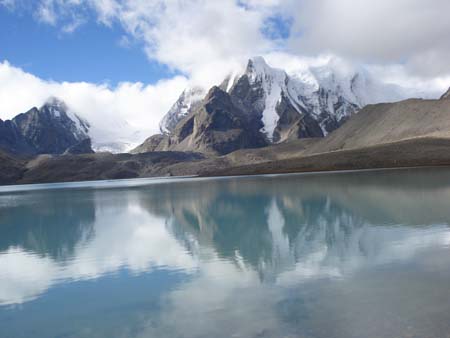 We leave at 9:00 AM after I get this last photo for sweet memories…
We leave at 9:00 AM after I get this last photo for sweet memories…
The next stop, Chopta Valley is one and a half hour away. On the way, I stop to take a photograph of these yaks grazing in the valley alongside the Lachen River.
Further ahead, three men alongside the road wave down the Sumo for a lift till somewhere ahead of Thangu. Tobgay asks for my permission. I don’t mind helping the strangers, so I give him the OK.
We reach Chopta Valley at around 10: 25 AM. Situated at a height of 13,200 feet, this is the second “Valley of Flowers” in North Sikkim after the more famous one at Yumthang. In Spring, the valley blooms with orchids, rhododendrons and other high altitude flora.
I step out to admire this lovely alpine valley surrounded by green mountains with thick looming clouds. Gigantic boulders, gushing rivers, sparkling streams…
Watch my video: Chopta Valley
Getting down, I walk along the road overlooking the valley, curious to see where it ends. Once again, I make the mistake of walking at a quick pace. After a 15-minute walk in the high-altitude cold and windy air, I experience shortness of breath and retrace my steps. But not before taking a few lovely photographs…
The Chopta River snakes up the middle of the valley…
After spending almost half an hour outside, I return to my Sumo, a little exhausted but very content. I feel better on the scenic drive, enjoying the old melodious Hindi film songs playing on the stereo. At Thangu, one of the men gets off. Tobgay has not stopped for food and refreshments. Isn’t he hungry after driving for so long?
It’s a beautiful day with the sun shining brightly. The lofty mountains that I had seen early morning under dark skies now look lush-green.

Watch my video: En route from Chopta Valley to Lachen – 1
This misty mountain takes my breath away…
Watch my videos: En route from Chopta Valley to Lachen – 2
En route from Chopta Valley to Lachen – 3
This beautiful land in the clouds has enchanted me completely. I feel sad seeing the barren side of a few passing lush-green mountains. Ughh… mountain blasting!
At one place, Tobgay slows down to let two wild hens cross the road. I have seen some of their kind at the Darjeeling zoo. But these ones look so cute strolling by, oblivious to an approaching vehicle! Is it lunch time? I check my mobile phone. It’s 12:15 PM. The remaining two men seated behind get off somewhere ahead.
We reach Lachen at around 1:00 PM. The moment I step out of the vehicle and remove my hat, my head feels heavy. I replace the hat, but still, my head feels terrible. I climb up the four floors, quickly unlock my room door, run indoors and flop down onto my bed. On removing my hat and woollen cap, I’m swamped by a terrible sensation. I have never experienced anything like this before. My head feels like it has been weighed down heavily and is splitting apart and my brains are getting squeezed inside. I rub my head hard, stopping short of pulling my hair apart. I think I might be dying. Or maybe not. Should I tell Bhaichung that I need a head massage? But after that, I’ll need a hair wash. Can’t go around with an oily head! Moreover, the boys will get scandalized by my request. The previous evening, when Bhaichung and two of his boys brought in my dinner, they left the door slightly ajar, letting cold gusts of icy wind in. When I told one of the boys to shut the door, he looked uncomfortable like… What??? She’s telling me to close the door when we three are still inside the room??? Shivering in the cold, I had to get up and close the door myself while they went on with their task of laying out my dinner.
So, I massage my head for about 15-20 minutes. It makes me feel better. I lie down for a while, covering myself head to toe with two thick blankets. Within half an hour, my lunch is at the door which I have kept unlocked for the boys to enter. I tell them to come in but they don’t. Uff! I get up, open the door letting them in, close the door and return to bed. I see that the food is the same as last evening…rice, dal, vegetable paneer, rotis. I feel like I could sleep forever and it would be wonderful. But I have to haul myself out of bed to get ready for the drive to Lachung. And I need to eat something to give me energy. So I have a bit of the vegetable paneer dish with roti and then the dahi. It makes me feel better.
If my splitting headache had been due to high-altitude sickness, I would have puked. The effect of AMS is such that whatever goes down the throat, be it food or water, comes up as soon as it hits the stomach. Most probably, it was because of the tight-fitting woollen cap that I had worn beneath my hat for almost nine hours. And then, I suddenly realize that throughout the uphill journey, I neither suffered nausea nor coughed.. not even once in the entire day from the time I woke up till now! And that’s very surprising considering that I have been coughing every half an hour over the past weeks.
By 3:15 PM, I’m ready to leave for Lachung. Bhaichung is sweet enough to carry my bag to the Sumo instead of calling one of his boys. In the car, I tell Tobgay about my headache and to my surprise, he says that even he had a headache. Oops, poor fellow! When we started for the lake, he wasn’t wearing any cap. He had said that he was used to high-altitudes.
The road passes alongside the Lachung River.
Watch my video: En route from Lachen to Lachung – 1
The scenic drive passes through thick jungles. At one place, Tobgay points out two Himalayan monkeys jumping on a nearby tree. It’s wonderful to watch them in their natural habitat. I had first seen this monkey species in captivity at Darjeeling zoo.
Close to Lachung, I see this beautiful scene. Typical mountain dwellings in the higher regions of the land…
Watch my video: En route from Lachen to Lachung – 2
Ten minutes later, we are at a roadside waterfall, the Bhim Nala Falls…
Watch my video : Bhim Nala Falls on the way to Lachung – 3
We reach Lachung at 5:00 PM. It’s a small village, though a bit larger than Lachen. I have decided to stay at the Lachung Fortuna hotel because it is well-equipped with room heaters. At the hotel, the manager tells me that the room tariff is 3000 rupees per night including breakfast, lunch and dinner. He is ready to give a 20% discount. Considering that it is off-season and they don’t have any guests at present, the discount is meagre. The manager agrees to make it 4500 rupees for the two-night stay.
The valley-facing room shown to me looks good with a splendid view of the surrounding mountains which are right now covered by clouds. I can hear the roaring sound of the Lachung River flowing through the valley, a short distance away. The bathroom is good, except for a few creepy crawlies that have got in through a slight gap in the window. A few minutes later, I’m gleefully gorging on a plateful of hot vegetable pakoras. The room heater keeps me warm in the freezing cold weather. I skip dinner and go to bed at around 9:00 PM.
Coming next: My Adventures in Darjeeling, Sikkim & Kalimpong – Part 6 of 7

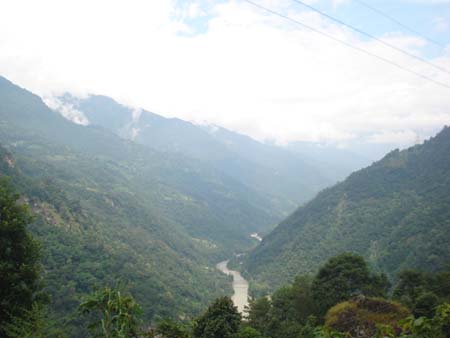





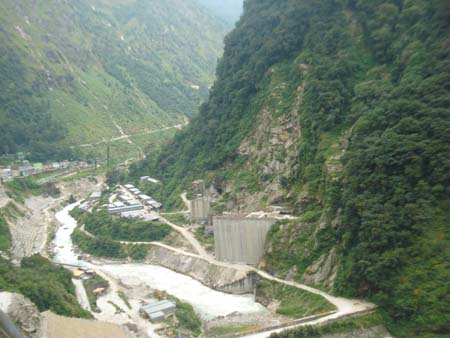

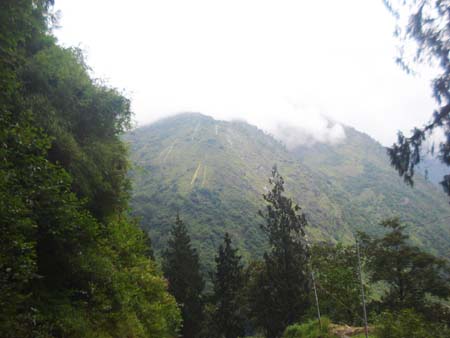


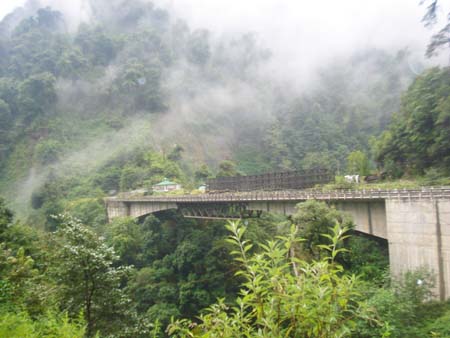
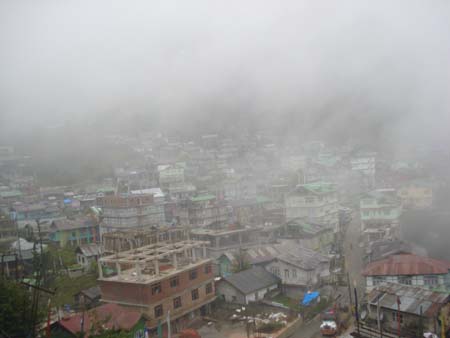




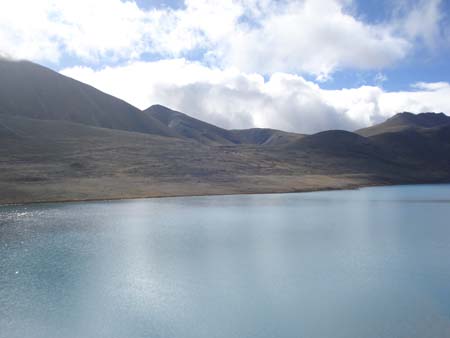
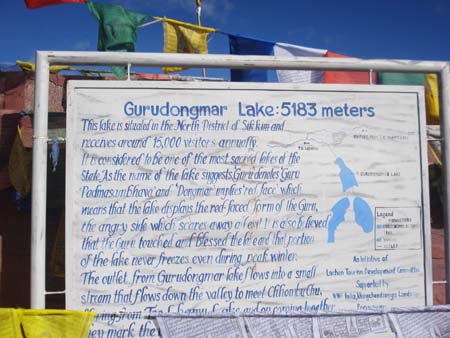
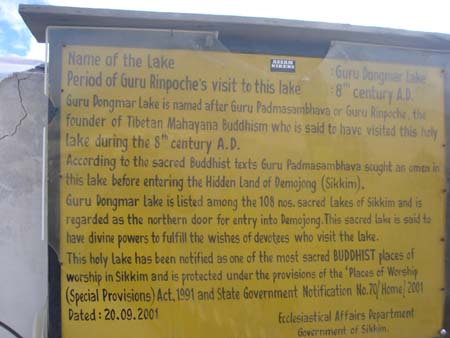

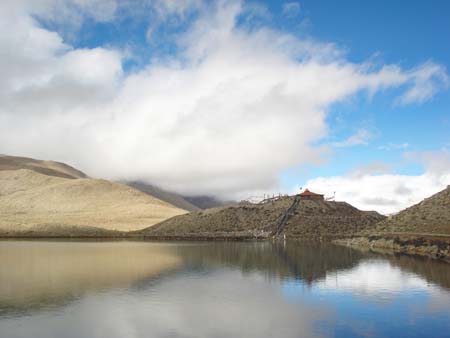







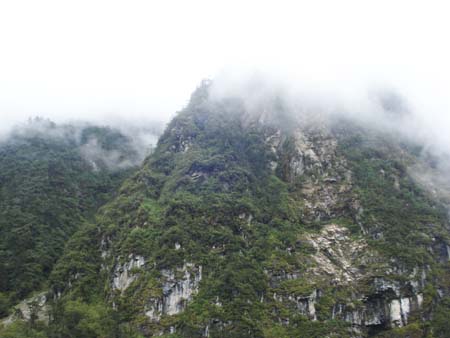





Love the beautiful and tranquil images of the lake!
LikeLiked by 1 person
Hi, Thanks so much. Cheers 🙂
LikeLike
Reblogged this on India Food Club.
LikeLike